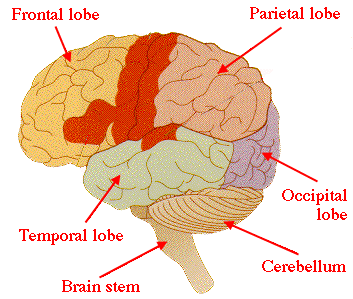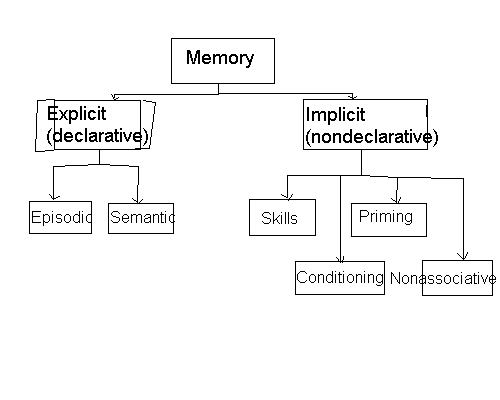Psychology
1.1 Brain-Behaviour Relationships
This part largely follows a course taught at La
Trobe University, autumn 2001
For a lot of excellent pictures of the brain, visit The Whole Brain Atlas at Harvard.

This picture is made by Emanuel Sferios, and is from an
excellent slideshow about basic neurobiology and MDMA-use, on dancesafe.org.
1.1.1 Certain brain structures

Brainstem
The brainstem consistst of the mesencephalon, the pons, and the medulla
oblongata.
Hindbrain
The hindbrain consists of the pons, the medulla oblongata, and the
cerebellum.
Sulci are the furrows or grooves in the brain, and gyri are the folds between them.
1.1.2 Divisions of the adult human brain
| Forebrain Telencephalon Diencephalon |
Midbrain Mesencephalon |
Hindbrain Metencephalon Myelencephalon |
The three functional units
- a unit for regulating tone; located in the brainstem
- a unit for obtaining, processing and storing information; located in
the retro-rolandic cortex
Each of these is hierarchical in structure and ach is composed of at least three cortical zones, built one on top of the other.
The cortical zones
The primary projection areas receive or send impulses to the periphery.
The secondary projection / association areas decode and prepare incoming
information and prepare programs. The tertiary areas are zones of overlapping,
where evaluation and programming occurs.
Luria's laws
The law of hierarchical structure of the cortical zones.
The law of diminishing specificity of the hierarchically arranged cortical
zones.
The law of progressive lateralization of function.
1.1.3 Research methods
- case study
- HM, Phineas Gage
- lesion production - temporal lobectomy
- brain stimulation
- ERPs, PET, fMRI
- brain recording - EEG
(electroencephalography)
- imaging
- CT, MRI
- neuropsychological assessment
- clinical
- fixed or flexible battery
- cognitive - specialised instruments
1.1.4 The limbic lobe
Limbus is Latin and means edge / hem / border; the limbic system is the
border of the brainstem. It is the only region of the cortex with direct
connection to the hypothalamus. It is thought to be active in emotion,
memory and aggression. The limbic system consists of
1. the hippocampus
2. anterior and dorso-medial nucleus of the thalamus
3. cingulate gyrus and parahippocampal gyrus
4. amygdala
5. septal ares
6. mammillary bodies
7. ? rest of the hypothalamus
1.1.4.1 Emotion
1.1.4.2 Memory

We say that there are three stages of memory: encoding - storage - retrieval.
1.1.4.2.1 Most common causes for permanent amnesia
- severe traumatic brain injury
- chronic alcohol abuse
- stroke
- epilepsy / temporal lobectomy
- degenerative disorders (DAT)
- anoxia (MCI, CO, drowning)
- schizophrenia
1.1.4.3 Aggression
Links